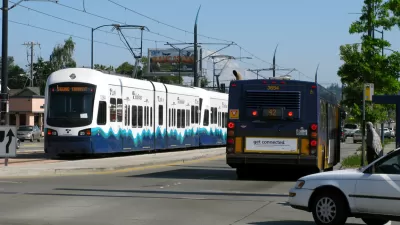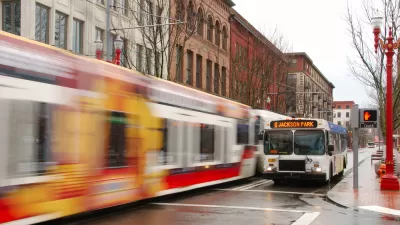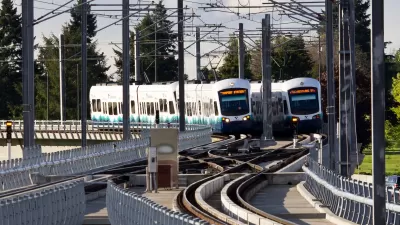Opponents of the ST3 transit funding measure in Seattle have argued that bus rapid transit is a cheaper alternative to light rail. A local write counter argues that point by making the economic case for light rail.

"A common criticism of the upcoming ST3 ballot measure is that light rail is too expensive and we’d be better off with bus rapid transit (BRT)," according to an article by Anton Babadjanov. In response to the argument for a less robust build-out of public transit infrastructure, Babadjanov examines the economics behind a range of proposed alternatives for addressing the congested state of roads around the region.
First, Babadjanov debunks the idea that wider highways would solve the Seattle region's traffic woes, based on concepts of induced demand and the massive size of the freeways that would be necessary to reach same level of lane-miles per capita as a city like Kansas City.
On the issue of buses, Babadjanov argues that for a bus to be an acceptable alternative to driving it needs to offer an alternative to traffic. Because long stretches of high-occupancy vehicle lanes are politically untenable, only new right-of-way remains as a path around congestion. But here's the rub: new right-of-way is actually the expensive part of constructing new light rail, and 80 percent of the cost for light rail in the ST3 proposal would go to right-of-way, according to Babadjanov.
So the argument goes: while Sound Transit is busy planning and building new right-of-way, it might as well make the most efficient use of it, with light rail instead of bus rapid transit.
FULL STORY: BRT Is Not Cheaper Than Light Rail

Planetizen Federal Action Tracker
A weekly monitor of how Trump’s orders and actions are impacting planners and planning in America.

Congressman Proposes Bill to Rename DC Metro “Trump Train”
The Make Autorail Great Again Act would withhold federal funding to the system until the Washington Metropolitan Area Transit Authority (WMATA), rebrands as the Washington Metropolitan Authority for Greater Access (WMAGA).

DARTSpace Platform Streamlines Dallas TOD Application Process
The Dallas transit agency hopes a shorter permitting timeline will boost transit-oriented development around rail stations.

Renters Now Outnumber Homeowners in Over 200 US Suburbs
High housing costs in city centers and the new-found flexibility offered by remote work are pushing more renters to suburban areas.

The Tiny, Adorable $7,000 Car Turning Japan Onto EVs
The single seat Mibot charges from a regular plug as quickly as an iPad, and is about half the price of an average EV.

Supreme Court Ruling in Pipeline Case Guts Federal Environmental Law
The decision limits the scope of a federal law that mandates extensive environmental impact reviews of energy, infrastructure, and transportation projects.
Urban Design for Planners 1: Software Tools
This six-course series explores essential urban design concepts using open source software and equips planners with the tools they need to participate fully in the urban design process.
Planning for Universal Design
Learn the tools for implementing Universal Design in planning regulations.
Municipality of Princeton
Roanoke Valley-Alleghany Regional Commission
City of Mt Shasta
City of Camden Redevelopment Agency
City of Astoria
Transportation Research & Education Center (TREC) at Portland State University
US High Speed Rail Association
City of Camden Redevelopment Agency
Municipality of Princeton (NJ)





























